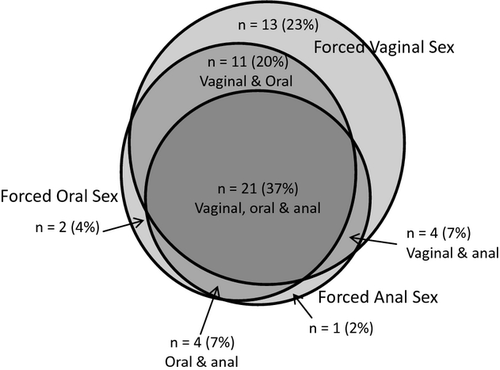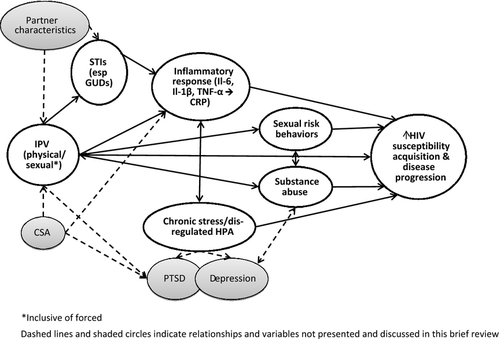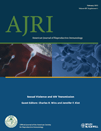Forced Sex and HIV Risk in Violent Relationships
Abstract
Problem
The intersecting epidemics of gender-based violence, specifically forced sex, and HIV continue to affect women worldwide. Both in the United States and worldwide, women of African descent are disproportionately affected.
Method of study
The current literature was reviewed for inclusion based on its relevance to the intersection of forced sex and HIV risk behaviors.
Results
This brief review synthesizes research on the linkages between forced sex and behavioral risk factors for HIV infection. We explore forced sex from the perspective of the perpetrator being a current or former intimate partner, as well as the first sexual intercourse experience occurring through the use of physical force (i.e., forced sexual initiation). The review also emphasizes the importance of expanding current research to understand the physiological mechanisms linking forced sex to HIV risk.
Conclusion
The factors linking intimate partner forced sex and forced sexual initiation with HIV/AIDS are varied and complex. The review concludes with recommendations for future research in this area and implications this research could have on preventing violence and mitigating the health consequences.
As we attempt to understand more fully the multiple facets of the intersections of HIV and gender-based violence for women,1 taking a fully integrated human perspective, from physiology to behavior, is essential. Most of the attention has focused on the behavioral sequelae of intimate partner violence (IPV) and sexual assault resulting in increased behavioral risk factors for HIV, such as women's reduced ability to use protective behaviors, and increased risk behaviors among violent male partners and among women victimized.2 However, the intersections related to ongoing rape in violent partner relationships have seldom been thoroughly explored in a physiological context. This brief review highlights the overlap between forced sex and HIV from the behavioral and physiological pathways and calls attention to areas for further investigation.
The field is fully aware that in certain regions of the world, women represent the majority of new HIV cases, and the greatest proportion of adults living with HIV.3 In the United States, HIV/AIDS disproportionately affects women of African descent; these women represent only 13% of the general female population but 64% of HIV cases among women.4, 5 Unprotected heterosexual sex is the primary transmission route for the majority of women in many areas of the world, often occurring with long-term partners who engage in high-risk behaviors.3
Global awareness is growing around the role that gender-based violence plays in the increasingly gendered patterns of the HIV epidemic and that the worldwide prevalence of sexual assault and IPV ranges from 13 to 62% of women, with lifetime prevalence most often estimated around 30%.6 According to the recent US population-based National Intimate Partner and Sexual Violence Survey (NISVS), 32.9% of women report a lifetime prevalence of physical IPV, 18.6% rape, and 44.6% other sexual violence, with 9.4% of women reporting lifetime partner rape.7 In the WHO multi-country study, 6–60% of partnered women reported physically forced sex with the highest rates in countries with high rates of physical violence.6, 8 In the United States, research has shown that approximately 30–40% of physically abusive relationships also include physically forced sexual acts, with the more violent abusive relationships most often characterized by sexual assault.9, 10
Although measurement of the frequency of intimate partner perpetrated sexual assaults occurs seldom, the acts are most often repetitive, thereby increasing the risk of HIV transmission. The use of physical force to penetrate precludes the woman even attempting to use safe sex practices and, importantly, often includes forced anal sex that increases the chances of acquisition of HIV. In our recent case–control study (n = 543 women abused by husbands, boyfriends, or ex-partners; n = 358 never abused women) focusing on women of African descent in the Unites States (Baltimore) and in the US Virgin Islands, 160 (37% of the 431 experiencing physical IPV) also reported experiencing physically forced sex (J. E. Draughon, M. B. Lucea, J. K. Stockman, M. T. Paterno, D. R. Bertrand, P. W. Sharps, D. W. Campbell, J. C. Campbell, Under Review). Of these, 38% reported forced vaginal penetration, 24% forced oral sex, 19% anal penetration, and 33% did not specify the type of forced sex. Over one-third (35%) of these women reported repetitive forced sex, with the highest percentage reporting repetitive experiences of all three types of forced sex (see Fig. 1).

In the same study, of the physically abused women, 174 (41%) reported having anal intercourse. The women who experienced physically forced sex were also over four times as likely to report inconsistent condom use at their last five acts of anal intercourse (AOR: 4.85, 95% CI: 1.03–22.81) (J. E. Draughon, M. B. Lucea, J. K. Stockman, M. T. Paterno, D. R. Bertrand, P. W. Sharps, D. W. Campbell, J. C. Campbell, Under Review). We were unable to determine condom use during the forced sex acts themselves.
Physically forced sexual initiation (most often the first sexual act within an ongoing male-female ‘dating’ relationship) is another form of partner forced sex with the increased friability of vaginal tissue among adolescents contributing to the possibility of HIV acquisition.11 Globally, physically forced sexual initiation is highly prevalent (ranging from 5 to 46%) and is associated with HIV risk behaviors including inconsistent or no condom use and multiple- and high-risk partners (i.e., casual partners, transactional sex partners), as well as HIV infection and/or other sexually transmitted infections (STIs) in the course of a woman's life span (J. K. Stockman, M. B. Lucea, J. C. Campbell, Under Review). In the only US population-based study on forced sexual initiation and HIV risk, among 5663 heterosexually active women, 12.5% had experienced a forced sexual initiation. Among 26% of women whose first sexual experience was at age 15 years or younger, 22% experienced forced sexual initiation. Women who had experienced a forced sexual initiation were significantly more likely to have had ten or more lifetime sex partners and sex with a high-risk partner in the past year compared with women whose first sex was voluntary. In addition, substance use in the past year mediated both associations: forced sexual initiation and ten or more lifetime sex partners, as well as forced sexual initiation and sex with a high-risk partner in the past year.12
The forced sex acts cannot only influence a woman's behaviors and abilities to negotiate safe sex, but they can also impact her physiological susceptibility to HIV. As detailed in this issue, local inflammatory responses can increase susceptibility to HIV infection by both recruitment of target cells to the site of injury and impairment of the integrity of the mucosal epithelial barrier. Pre-infection inflammation in women increases HIV-infection rates in the laboratory and in vivo, which may explain the increased transmission of HIV to women who have STIs or any open vaginal lesions. Women physically abused by partners have long reported increased rates of other STIs as well as HIV.13-15 Additionally, research has found that abused women experience long-term immune system dysfunction including pro-inflammatory responses of increased cytokines.16, 17
Additionally, forced or consensual intercourse can cause an increase in CD4+ cells in the cervical epithelium,18 hypothesized to be a direct result of the exposure of vaginal and cervical cells to seminal fluid.19 In the context of IPV where negotiation of condom use may not be possible and other pro-inflammatory processes due to the trauma of abuse may have caused immune dis-regulation, these normal alterations in the vaginal and cervical mucosa may further increase the risk of HIV transmission.
The relationship between IPV and HIV susceptibility is complex (see Fig. 2). As this review has discussed and as this figure conveys, both physical and sexual IPV increase sexual risk behaviors as well as substance abuse. In turn, these behaviors are linked to increased HIV risk. Physiologically, IPV causes changes in the inflammatory response, which can lead to increased HIV susceptibility on its own, or alternatively, the change in the inflammatory cascade can couple with disregulation of the hypothalamic-pituitary-adrenal (HPA) axis, thereby increasing HIV susceptibility and disease progression. An additional pathway may include transmission of STIs by an infected abusive partner through non-condom use. These STIs then begin the pathway to increased HIV susceptibility through altering the inflammatory response.

These complex pathways demand interdisciplinary translational research to fully understand exactly what is occurring as the basis for more comprehensive interventions. To design interventions to both prevent acquisition and deter progression that fully take into account women's exposure to violence as well as her physiology, a more comprehensive program of research needs to occur with interventions that are tested with physiological as well as psychosocial and behavioral outcomes. Additional research in the form of longitudinal, prospective studies could further examine the causal relationships conveyed in Fig. 2. This can then inform interventions promoting primary prevention of violence and forced sex and secondary and tertiary prevention of health consequences through the interruption of the pathways. Women's relationships and trauma exposure may be as important as their behavioral risks in both prevention and treatment for HIV/AIDS. Women's lives as well as their health depend on our taking a more holistic view in our research and interventions. Ultimately, elucidating these causal relationships and developing targeted interventions will facilitate reductions in HIV infections among women worldwide, with the most significant impact observed in women of color.
Acknowledgments
This original research discussed in this review was supported by the Caribbean Exploratory Research Center, University of the Virgin Islands, NIMHD (P20MD002286). M.B. Lucea is supported by the NICHD (T32HD064428) and NIMHD (L60MD006272). J.K. Stockman is supported by NIDA (K01DA031593), NIMHD (L60MD003701) and NIMH (R25MH080664). The contents of this article are solely the responsibility of the authors and do not necessarily represent the official views of the National Institutes of Health.




